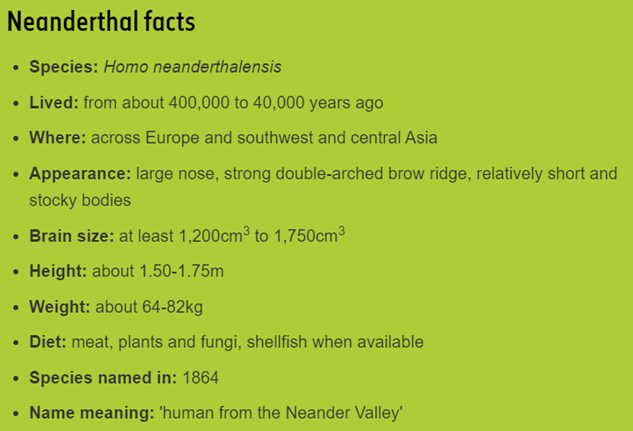Neanderthals

Disclaimer: Copyright infringement not intended.
Context
- A comparison of the genomes of a Neanderthal who lived 120,000 years ago in Siberia with those of modern humans in sub-Saharan Africa has revealed insight into the migratory and interbreeding history of both species.
Details
Who are Neanderthals?
- Neanderthals were primitive people who went extinct around 40,000 years ago.
- They appear to have originated in Europe and then spread to Southwest, Central, and Northern Asia.
- For a long time, Neanderthals were supposed to be the typical caveman, rude and mentally unevolved.
- Scientific research in the early 1900s depicted Neanderthals as gorilla-like creatures, an extinct offshoot of humanity that couldn't compete with thin, bright people.
Recent Findings
- Neanderthals and anatomically modern humans initially interbred 250,000 years ago, a date that is far earlier than previously thought, a new study suggests.
- Until now, Neanderthals and anatomically modern humans (Homo sapiens) were believed to have first interbred earlier than 75,000 years ago, according to a 2016 genetic analysis in the journal Nature.
- However, a new analysis, published Oct. 13 in the journal Current Biology, has revealed that one group of Homo sapiens from Africa interbred with Neanderthals in Eurasia around 250,000 years ago.
- This group of humans died out but left a genetic footprint in the DNA of Neanderthals that descended from this interbreeding event with 6% of the genome of a Neanderthal discovered in Siberia containing human DNA.
- Some sub-Saharan populations of anatomically modern humans also inherited Neanderthal DNA when groups of humans who had interbred with Neanderthals migrated back into Africa.
- In the new study, the genome of the 122,000-year-old "Altai Neanderthal" from Siberia with those of 180 people from 12 modern sub-Saharan African populations.
- They then developed a statistical tool to uncover the origins of the Neanderthal DNA in the modern human genome.
Features
- Their skulls are distinguished by a big central region of the face, angled cheekbones, and a massive nose for humidifying and warming cold, dry air.
- Another adaptation to living in frigid locations was that their bodies were shorter and stockier than modern humans.
- But their minds were exactly as big as current humans', if not bigger - proportionate to their bigger bodies.
- Their bones show that they were highly muscular and robust, but they endured harsh lives and were frequently injured.
- Neanderthals created and used a diverse collection of complex tools, regulated fire, lived in shelters, constructed and wore clothes, were skilled hunters of large animals, ate plant foods, and made symbolic or beautiful artifacts on occasion.
- According to fossil evidence, Neanderthals, like early humans, created a variety of sophisticated tools out of stone and bones. Small blades, a hand axe, and scrapers were used to remove flesh and fat from animal hide.
- There is evidence that Neanderthals buried their deceased carefully and even marked their tombs with tributes such as flowers.
Some Facts of Neanderthals

|
PRACTICE QUESTION Q. How has the study of Neanderthals contributed to our understanding of human evolution and the origins of Homo sapiens? Explain with examples and recent findings." |




1.png)
